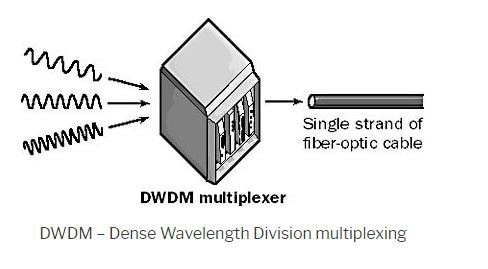
 Data Structure
Data Structure Networking
Networking RDBMS
RDBMS Operating System
Operating System Java
Java MS Excel
MS Excel iOS
iOS HTML
HTML CSS
CSS Android
Android Python
Python C Programming
C Programming C++
C++ C#
C# MongoDB
MongoDB MySQL
MySQL Javascript
Javascript PHP
PHP
- Selected Reading
- UPSC IAS Exams Notes
- Developer's Best Practices
- Questions and Answers
- Effective Resume Writing
- HR Interview Questions
- Computer Glossary
- Who is Who
What is Dense Wavelength division multiplexing (DWDM)?
Dense wavelength division multiplexing (DWDM) is a technology that multiplexes data signals from different sources so they can share a single optical fibre pair while maintaining complete separation of the data streams.
DWDM can handle higher speed protocols up to 100 Gbps per channel. Each channel is only 0.8nm apart. Dense wavelength division multiplexing works on the same principle as CWDM but in addition to the increased channel capacity it can also be amplified to support much longer distances.
The diagram given below represents the dense wavelength division multiplexing (DWDM) −

Working of DWDM
The working of DWDM is explained below −
DWDM modulates multiple data channels into optical signals that have different frequencies and then multiplexes these signals into a single stream of light that is sent over a fibre-optic cable.
Each optical signal has its own frequency, so up to 80 data streams can be transmitted simultaneously over the fibre using only eight different light wavelengths.
DWDM based networks can transmit data in IP, ATM, SONET/SDH, and Ethernet and can handle bit rates between 100 Mb/s and 2.5 Gb/s. Therefore, DWDM based networks can carry different types of traffic at different speeds over an optical channel.
At the other end, a multiplexer demultiplexes the signals and distributes them to their various data channels.
Devices that support DWDM are more costly because the laser light sources for generating signals over fibre must be highly stable.
Technical advantages of DWDM
The technical advantages of DWDM are explained below −
Transparency − Because DWDM is physical layer architecture it can transparently support both TDM and data formats such as ATM, Gigabit Ethernet, ESCON, and Fibre Channel with open interfaces over a common physical layer.
calability − DWDM can leverage the abundance of dark fibre in many metropolitan area and enterprise networks to quickly meet demand for capacity on point-to-point links and on spans of existing SONET/SDH rings.
Dynamic provisioning − Fast, simple, and dynamic provisioning of network connections give providers the ability to provide high bandwidth services in days rather than months.
Features
The features of dense wavelength-division multiplexing are as follows −
It is a type of technology that increases the bandwidth while transmitting data signals over the fabric.
The signal carrying capacity can be increased to a large extent. The speed of the data signals can be up to 400 Gbps.

